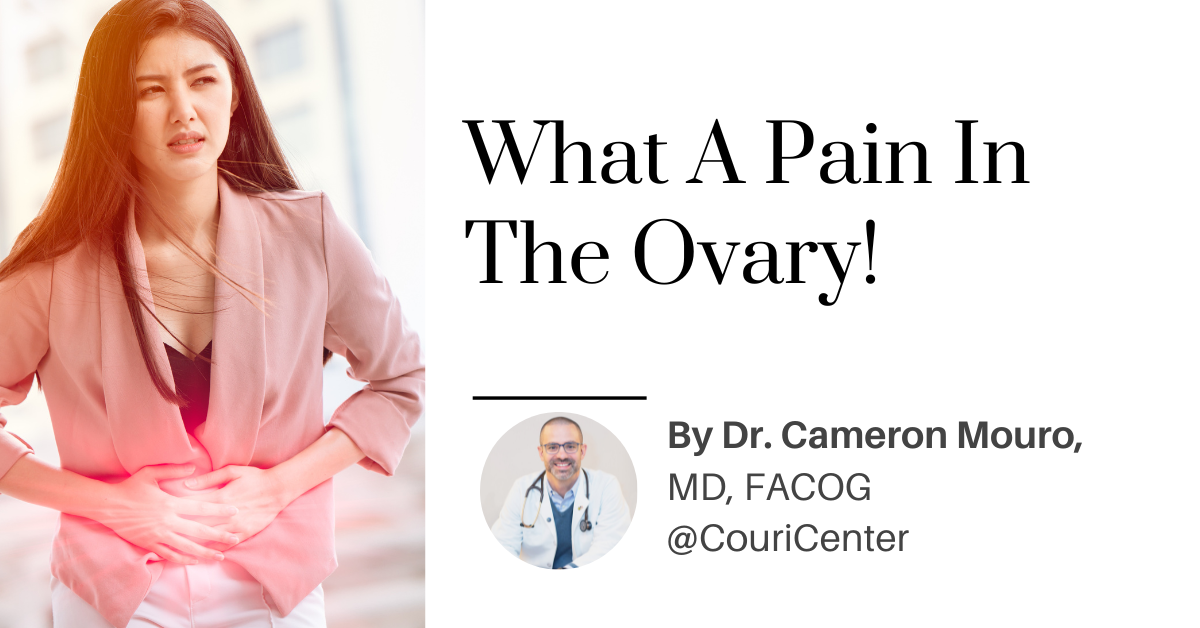
The ovaries are an incredible organ. They may be small, typically not much bigger than a walnut, but they play a vital role in a woman’s reproductive and overall health. They are the main producer of estrogen in the body and the incubator for all the eggs a woman has at the start of her reproductive years. Every menstrual cycle, there is a significant amount of activity going on in each ovary, and, unfortunately, that activity can often result in pain. Knowing the cause of the pain and when to worry about it can be challenging. Below are some common causes of ovarian pain, the explanation of which will hopefully take the mystery out of the pain.
Mittelschmerz
German for “middle pain,” mittelschmerz is the term for the pain that happens with ovulation, typically midway through the menstrual cycle. Ovulation is the release of an egg from the ovary to be fertilized. This process involves the bursting of a fluid-filled cyst that surrounds the egg, a process that, for some women, can be quite painful. Typically, mittelschmerz is a lower abdominal and pelvic pain occurring on the side ovulation occurred. It can be mild achy or cramping pain, but also can be sharp and stabbing. Mittelschmerz may last only a few hours or can be as long as a few days. Usually, it is relieved with heat and/or over-the-counter pain medications such as ibuprofen or naproxen. Although painful, it is from the normal functioning of the ovary and can be helpful for women who are trying to determine the timing of ovulation. However, when the pain is severe and negatively affects the quality of life, prevention with medications like the birth control pill should be considered.
Follicular Cysts
Every menstrual cycle the ovaries are each preparing several eggs, typically only one of which is ovulated. This preparation process involves the formation of a fluid-filled cyst, called a follicle, around each egg. As the cycle progresses, each follicle grows, but typically no larger than a centimeter or two. Unfortunately, like many things in the body, the follicles don’t always follow the “rules” and grow too much. This growth can occur without causing any symptoms, but some women with a follicular cyst will experience pain. It is typically a pressure or achy pain in the pelvic area, on the side that contains the cyst. It can sometimes be sharp in nature but is rarely severe. A follicular cyst will take one or two full menstrual cycles to resolve completely, but the pain decreases sooner, typically after 1-2 weeks, as the cyst begins to shrink. An ultrasound is usually repeated about 8 weeks after the cyst is first diagnosed to confirm resolution. Thankfully, developing a follicular cyst is usually an isolated event. However, for women who have recurring cysts, prevention can be accomplished with hormonal birth control.
Hemorrhagic Cysts
Sometimes bleeding, also called hemorrhage, can occur inside an ovarian cyst. If it happens, it most commonly occurs inside the corpus luteum, the structure that forms in the ovary after ovulation. This bleeding can be quite painful and happens during the second half of the menstrual cycle, 1-2 weeks before the next period is expected. The pain is usually gradual in onset, but sharp, stabbing, and constant. It often requires regular dosing of either Tylenol or ibuprofen or both, to relieve the pain and can last 3 to 5 days. The bleeding itself is small in amount and limited, staying trapped inside the cyst. Over the course of a few weeks, the blood is reabsorbed, and the cyst resolves. Like follicular cysts, hemorrhagic cysts are most often isolated events and do not occur repetitively.
Cyst Rupture or Ovarian Torsion
The above examples are the most common causes of ovarian pain, and although sometimes distressing, they are not emergent situations, nor do they require specialized treatment. However, an ovarian cyst, follicular or hemorrhagic, can sometimes rupture or cause ovarian torsion. Both of these events are emergent situations. The rupture of a cyst can cause internal bleeding and ovarian torsion causes a cutting off of normal blood flow to the ovary. Both rupture and torsion manifest with severe pain. This pain is distinguished from Mittelschmerz and pain from the above-described cysts by its sudden onset and severity level. It is so sudden that most women who experience cyst rupture or torsion are able to describe exactly what they were doing when the pain started. Additionally, the pain is often described as excruciating and does not respond well to over-the-counter pain medication. Thankfully, ovarian cyst rupture and ovarian torsion are rare events, but the onset of such pain does require prompt evaluation in the emergency department.
During the course of a menstrual cycle, several processes can cause pain or discomfort, including normal activity within the ovaries. Most of these pains are short-lived and manageable with over-the-counter medications and heat. Sometimes, however, these normal processes can negatively affect the quality of life or lead to more distressing pain. If you are experiencing such pain, we are here to help. Schedule your visit online via our convenient patient portal, or call 309-692-6838. New patients are welcome.
Dr. Mouro
